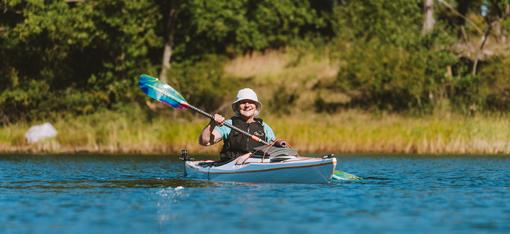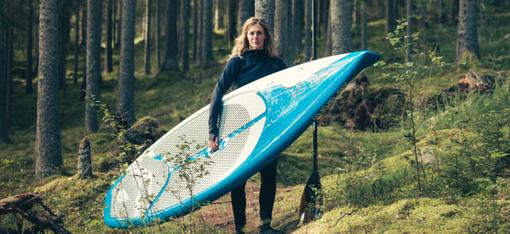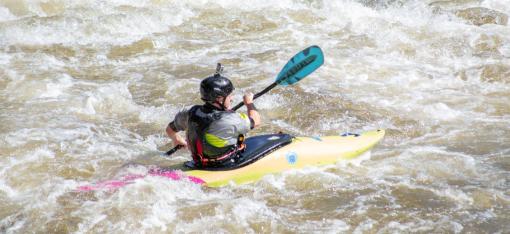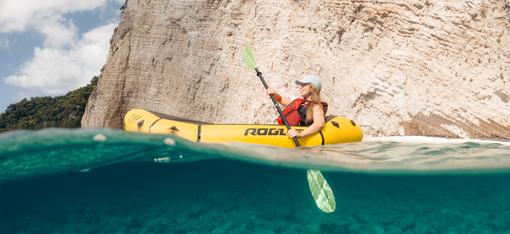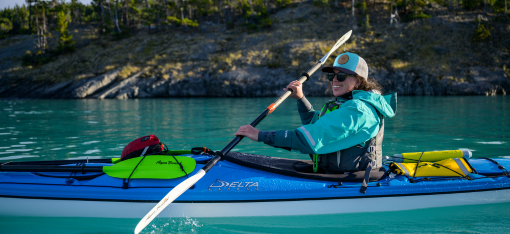How to Capture Whitewater Kayakers on Waterfalls with Dynamic Video
5-minute read + 10-minute video
So you’ve seen these epic videos of whitewater kayakers taking on waterfalls and want to be able to create those same kinds of videos. Seth Ezekiel West tells you how in his video…

Seth West is an outdoor lifestyle photographer and videographer who’s been handling our social media for a couple of years now. He has loads of experience in this area and generously shares tips for others on his YouTube channel.
Today, let’s take a look at his best suggestions (and biggest mistakes) for creating dynamic videos of whitewater kayakers going over waterfalls:
“One of the greatest challenges,” says Seth, “can be taking these people and these athletes who are really fast moving and turning what they’re doing into these buttery, really nice smooth shots. You don’t always want to do that…but there are some moments where you just really need to slow things down and exemplify the beauty of what’s happening.”
Seth has dialed in his process of shooting waterfalls with whitewater kayakers over the years, combining the adrenaline-pumping action with those slow-moving segments that capture the beauty.
But first…
A Common Beginner’s Mistake
Seth says one huge mistake he made when first starting out was in framing his shots.
He wanted to frame them tightly on the subject (in this case, the kayaker) to get an intimate feel—something you can’t get watching in person when the very logistics of these locations require space.
But he soon realized that when zooming in that tightly on an object moving that quickly, he couldn't keep his subject matter in the frame.
He says, “If you’re in super tight, you’re going to miss a lot of shots. People are just going to fly right out of the frame, and then you have nothing to work with.”
You don’t want to go to the trouble of getting to location and setting up all your gear with no good footage to show for it.
Instead, go a little wider than you may think is necessary. You don’t want the kayaker to fill the frame from top to bottom. If you do, it’s too easy for part of the subject to be out of the shot too often:

If you’re shooting in 4K, you can always crop later. Shooting wider gives you margin for error that you can correct or tighten in post-production.
Encompass the Whole Waterfall at Times for Drama
Part of the drama of kayaking over a waterfall is the scale of the falls in relation to the kayaker.
“Say this water falls 100 feet and this kayaker is a 6-foot-tall person in a 9-foot boat,” Seth says. “They’re just teeny on this big thing. I’ll often lock off a second camera on a tripod. That’s not an option for a lot of people, but maybe you can set a phone over in a tree or up against a rock. I used to do that before I had two cameras.”

You can keep your phone or second camera focused on the big picture while you shoot closer to the action with your main camera.
About Camera Lenses
Seth really likes using a 24-105 lens, which allows him more options at each location for getting those wider shots. A 70-200 or 70-300 lens limits where you can position yourself.
He was once at a location with his 70-300 lens where the only viable shooting spots were too close, and he was forced to shoot too tightly. It was then he started to take his 24-105 along as well, so he wasn’t so limited.
“If you can, have two lenses with you. One that gives you a slightly wider option, and then a telephoto zoom as well.”
What’s the Best Camera to Use?
Seth is a big believer that “the camera you have is the best camera to shoot with. I don’t think you need to buy a new camera to learn stuff.” You can learn with the gear you have.
You can always upgrade to a new, better camera once you’ve learned all you can with your current one.
Nice-to-Have Gear
Two items Seth recommends are:
A 4K camera—it offers more forgiveness to be able to shoot wider and crop later.
A camera with built-in stabilization, which is almost all cameras made within the past couple of years.
Another item he’s learned to appreciate and now uses consistently as part of his process is a fluid head tripod. This type of tripod allows you to keep following the kayaker’s action over the waterfall in one smooth motion.
He found (by trial and error) that it’s worth it to invest in a quality fluid head tripod over an Amazon special. He uses the Benro S4 head. Its performance is top-notch when matched with a quality tripod.
[Be sure to watch starting at minute 8:03 in the above video as Seth demonstrates how a fluid head works.]

Get to Location Early
Part of Seth’s process is getting to the waterfall location and setting up his cameras before any of the action is ready to begin.
He adjusts his fluid head tripod so he can move his camera at the same speed as the water is coming over the falls. The kayaker will be roughly moving at that same speed.
He says, “You can be a lot more accurate if you do a bunch of practice shots and really dial in that speed.”
A Word About Stabilization
When using his fluid head tripod, Seth has learned he gets better results by turning stabilization off on his camera. Before he did that, he would still get some screen wobbles when shooting at high frame rates.
With stabilization off, he has the option to apply stabilization in post-production, which works better for him.
Stabilization is still key anytime you shoot hand-held, though, so having cameras with that feature is best.
* * * * *
We hope this has inspired you to go out and shoot your own waterfall and kayaking videos!
To see Seth’s techniques in action, see his short film, Tears of the Gods, from footage shot in Norway in June 2025.
Follow Seth on YouTube for more footage and tips.
All still photos also courtesy of Seth Ezekiel West.
What paddling questions can our friendly Customer Service team help you with? Contact us at 715-755-3405 or sales@aquabound.com, or choose our online chat option.
More for you...

